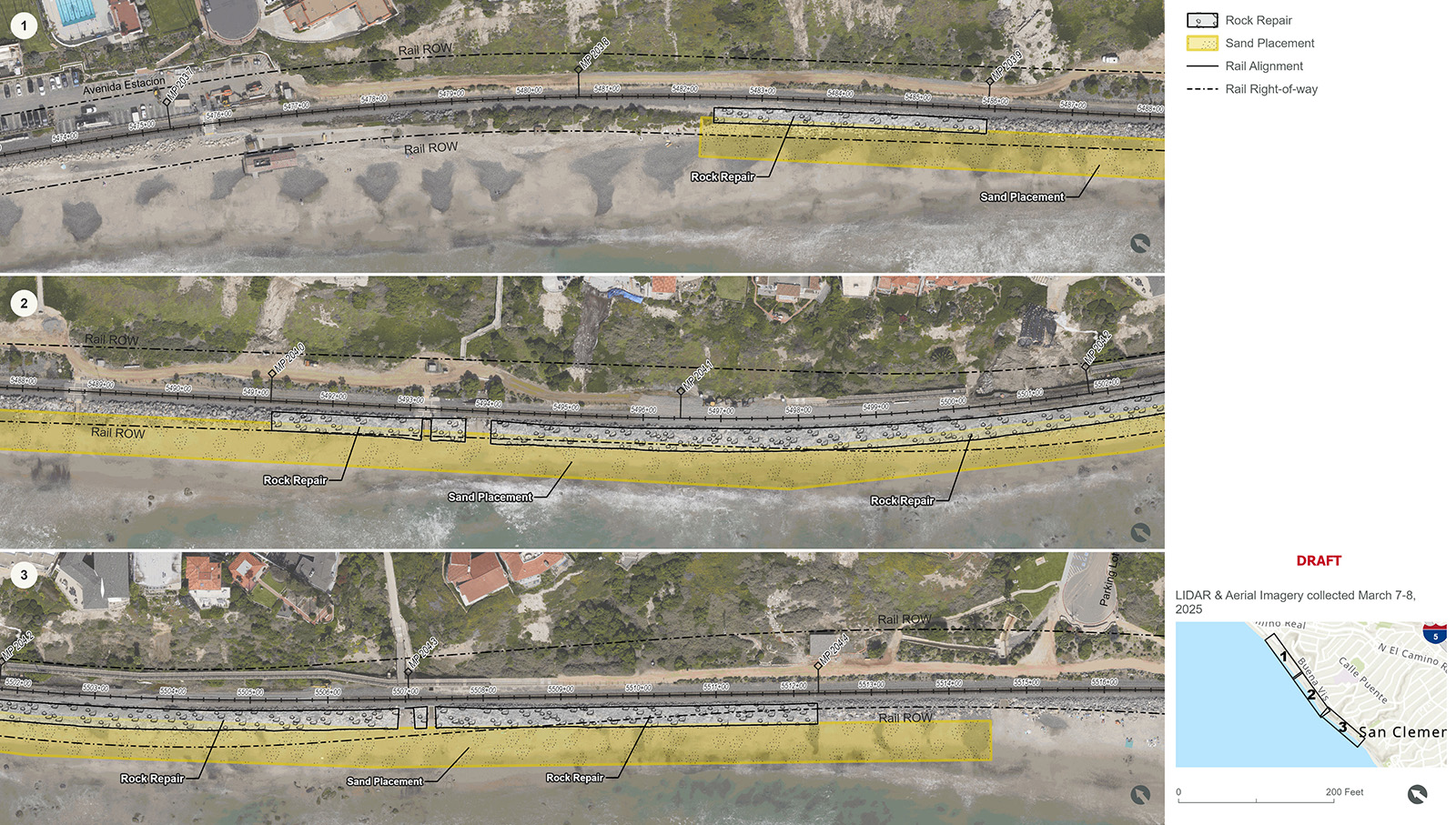Coastal Rail Emergency Projects
Frequently Asked Questions
General
OCTA is taking the following actions and implementing a comprehensive approach to protecting the rail line. These actions include:
- OCTA issued an emergency request for information for contractors to provide dredging and transport options to expedite the sand placement component of the projects. OCTA expects to place approximately 540,000 cubic yards of sand.
- On April 14, the OCTA Board authorized the CEO to enter into emergency contracting agreements to expedite work on the four Coastal Rail Stabilization Priority Projects. The board action allows OCTA to:
- Issue an emergency design-build procurement to include construction of a catchment wall along Mariposa Point, restoration of the pedestrian trail, and to build a revetment, seawall or functionally equivalent structure south of San Clemente State Beach.
- Direct Metrolink to repair and replace existing riprap, limiting the amount to only what’s necessary to protect the track, estimated at 6,500 cubic yards.
Funding
OCTA has been awarded $305 million for the projects through state and federal grants. The funding includes:
- California State Transportation Agency (CalSTA) awarded $125 million to OCTA through the Transit and Intercity Rail Capital Program (TIRCP)
- Federal Railroad Administration (FRA) awarded $100 million in funding from its Consolidated Rail Infrastructure and Safety Improvements (CRISI) program.
- California Transportation Commission awarded OCTA $80 million from the Trade Corridor Enhancement Program (TCEP)
Schedule
Each project activity occurs on a different timeline based on its complexity, and availability of contractors and material. Impacts to rail service and beach access will be communicated with the public when schedules of specific activities are finalized.
Riprap repair in Areas 1 and 2 began in mid-April and was completed in early June. Construction to build the catchment wall and restore the pedestrian trail in Area 3 began in September 2025 and is expected to be completed in summer 2026. The scheduled to build engineered revetment in Area 4 is still being determined.
Regarding the sand placement aspect of the project, OCTA needs to determine a suitable source for sand to be placed on the beaches in San Clemente. The source site sand needs to be tested and evaluated for suitability with the placement site. Design for the sand nourishment is also being advanced in order to procure a contractor with hopper-dredge equipment. Timing for this project component will become clearer when submissions are received in response to OCTA’s request for information.
Construction
The Project aims to restore existing degraded riprap protection to the tracks from ongoing wave damage and beach erosion that has resulted in overall riprap loss from the standard design section, over-steepened slopes, unstable stones, exposure of the rail embankment to wave action, and overall degradation in protective capacity to the rail embankment in San Clemente. In addition, approximately 240,000 cubic yards of sand will be placed in total in Areas 1 & 2.
The work area was also extended to the areas between Project Areas 1 and 2 (referred to as Area 1a) to safely and effectively protect the entire rail line through that segment. The modification approved by the California Coastal Commission added a 530-foot-long segment of riprap slope repair and reinforcement.
The Project is constructing a catchment wall, sized to capture and retain any potential debris and soil that may dislodge from the hillside due to additional movement. Additionally, the catchment wall will protect the existing railroad tracks within the entire Area 3 while reconstructing the pedestrian trail that was destroyed in the previous landslide. The improvements are not intended to stabilize the slope but rather protect the railroad right-of-way from future hillside movement. Learn more here.
All riprap placement will mostly be within OCTA’s existing railroad right-of-way. The work in Area 1 and 2 repaired the existing riprap section and maintained the original embankment shape within the railroad right-of-way and not extend further into the beach than today. Both areas will also include additional sand nourishment, which will increase the width of the beach through the Project areas.
The Project for Area 4 includes both riprap repair and proposed engineered structure sections in areas where existing riprap does not exist, and where extensive erosion has been observed along the track embankment. The engineered section will be built mostly within the existing railroad right-of-way. In addition, sand nourishment will be included in Area 4, which will increase the width of the beach through the project area.
